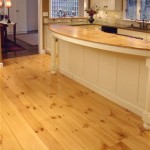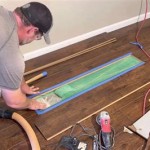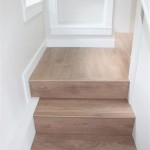Tips For Installing Bamboo Flooring On Concrete Floor
Bamboo flooring offers a durable and aesthetically pleasing alternative to traditional hardwood. Its sustainability and unique grain patterns make it a popular choice for homeowners. However, installing bamboo flooring on a concrete subfloor presents specific challenges that must be addressed for a successful and long-lasting installation. This article outlines essential tips and considerations for achieving a professional bamboo flooring installation over concrete.
Concrete, while structurally sound, can harbor moisture, which is detrimental to bamboo flooring. Excess moisture can cause warping, cupping, and mold growth, compromising the floor's integrity and appearance. Therefore, proper preparation and the use of appropriate materials are paramount.
Testing the Concrete for Moisture
A critical initial step is to assess the concrete's moisture content. Concrete can absorb moisture from the ground or retain residual moisture from the construction process. Failing to address excessive moisture levels will inevitably lead to flooring failure.
Several methods exist for testing moisture levels. A calcium chloride test (anhydrous calcium chloride test) is widely regarded as the most accurate and reliable method. This test involves placing a measured amount of calcium chloride under a sealed dome on the concrete surface for a specified period (typically 72 hours). The calcium chloride absorbs moisture from the concrete. By weighing the calcium chloride before and after the test, the moisture vapor emission rate (MVER) can be calculated in pounds per 1,000 square feet per 24 hours. Most bamboo flooring manufacturers specify a maximum MVER for installation; exceeding this limit necessitates moisture mitigation strategies.
Alternatively, a relative humidity (RH) test can be performed using in-situ probes inserted into drilled holes in the concrete. These probes measure the relative humidity within the concrete slab. The acceptable RH level also varies depending on the bamboo flooring manufacturer's recommendations. Typically, an RH reading above 75% requires moisture mitigation.
Another, less precise, method is using a concrete moisture meter. These meters provide a quick, non-destructive reading of the moisture content near the surface of the concrete. While convenient, these meters are susceptible to inaccuracies due to surface contaminants and may not accurately reflect the moisture levels deeper within the slab. For a definitive assessment, the calcium chloride or RH test are preferable.
If the moisture test reveals excessive levels, moisture mitigation becomes essential. Several options exist, including applying a topical moisture barrier or installing a subfloor system with a vapor barrier.
Preparing the Concrete Subfloor
Proper subfloor preparation is crucial for ensuring a level, clean, and structurally sound surface for the bamboo flooring. This involves several steps, including cleaning, leveling, and addressing any cracks or imperfections.
Begin by thoroughly cleaning the concrete surface. Remove any debris, dust, paint, adhesives, or other contaminants. Sweeping or vacuuming is insufficient; use a concrete grinder or scraper to remove stubborn residues. A degreaser may be necessary to eliminate oil or grease stains. After cleaning, rinse the surface thoroughly and allow it to dry completely.
Next, inspect the concrete for cracks, holes, or unevenness. Small cracks (less than 1/8 inch) can be filled with a concrete crack filler. Larger cracks should be addressed with a concrete patching compound. For substantial unevenness, self-leveling concrete can be applied to create a perfectly level surface. Follow the manufacturer's instructions carefully when using self-leveling concrete, ensuring proper mixing and application techniques.
After patching and leveling, grind the entire concrete surface to remove any remaining imperfections and create a slightly rough texture. This improves adhesion for the adhesive or underlayment. A concrete grinder with a diamond grinding wheel is ideal for this purpose. Be sure to wear appropriate safety gear, including a dust mask and eye protection, when grinding concrete.
Finally, vacuum the surface again to remove any dust created during the grinding process. A clean, level, and properly prepared concrete subfloor is essential for a successful bamboo flooring installation.
Choosing the Right Installation Method
Several methods are available for installing bamboo flooring over concrete, each with its own advantages and disadvantages. The choice depends on factors such as the type of bamboo flooring (solid vs. engineered), the moisture level of the concrete, and the installer's preference.
Direct Glue-Down Installation: This method involves directly adhering the bamboo flooring to the concrete subfloor using a specialized adhesive. It is generally suitable for engineered bamboo flooring, which is more dimensionally stable than solid bamboo. The direct glue-down method provides a solid, stable floor with good sound insulation. However, it requires a perfectly level and clean subfloor to ensure proper adhesion. Furthermore, the adhesive must be compatible with both the concrete and the bamboo flooring. Using the wrong adhesive can lead to bonding failures and flooring damage.
Floating Installation with Underlayment: This method involves installing the bamboo flooring over a separate underlayment that is not directly adhered to the concrete. The bamboo planks are typically clicked or locked together, creating a "floating" floor that is independent of the subfloor. This method is often preferred for its ease of installation and its ability to accommodate minor subfloor imperfections. The underlayment provides cushioning, sound insulation, and a moisture barrier. When installing a floating floor over concrete, it is crucial to use an underlayment specifically designed for concrete subfloors and that includes a vapor barrier to prevent moisture migration. It is essential to choose an underlayment that meets the bamboo flooring manufacturer's specifications for thickness and density.
Installation with a Wood Subfloor System: This method involves installing a wood subfloor over the concrete, creating a more traditional wood flooring installation. This approach is often used when the concrete subfloor is significantly uneven or when a higher level of insulation or soundproofing is desired. The wood subfloor can be constructed using plywood or oriented strand board (OSB), attached to the concrete with adhesive and mechanical fasteners. A vapor barrier should be installed between the concrete and the wood subfloor to prevent moisture from damaging the wood. Once the wood subfloor is in place, the bamboo flooring can be installed using nails, staples, or adhesive, depending on the type of bamboo flooring.
Regardless of the chosen method, acclimatizing the bamboo flooring to the environment is crucial. Store the flooring in the room where it will be installed for at least 72 hours prior to installation. This allows the bamboo to adjust to the temperature and humidity levels, minimizing expansion and contraction after installation.
Proper expansion gaps must be left around the perimeter of the room and around any fixed objects, such as pipes or columns. These gaps allow the bamboo flooring to expand and contract without putting pressure on the surrounding walls or structures. The recommended expansion gap typically ranges from 1/4 to 3/8 inch, depending on the manufacturer's recommendations.
Carefully read and follow the bamboo flooring manufacturer's instructions for installation. These instructions provide specific details about the recommended installation methods, adhesives, underlayments, and expansion gaps. Deviating from the manufacturer's instructions can void the warranty and lead to flooring problems.
Installing bamboo flooring over concrete requires careful planning and execution. By thoroughly testing the concrete for moisture, properly preparing the subfloor, and selecting the appropriate installation method, achieving a beautiful and durable bamboo floor is entirely possible. Remember to prioritize moisture mitigation and adhere to the manufacturer's guidelines for a successful and long-lasting installation.

Beginners Guide To Installing Bamboo Flooring The Company

How To Fit Bamboo Flooring Onto Concrete The Company

Glue Down Installation Bamboo Hardwood Floor Over Concrete Slab Wood Sub

How To Install Bamboo Flooring Part 2

Beginners Guide To Installing Bamboo Flooring The Company

Tips And How To Install Cali Bamboo Vinyl Pro Plank Flooring Diy Vinylfloor

Glue Down Installation Bamboo Hardwood Floor Over Concrete Slab Wood Sub

Can I Nail Down Bamboo Flooring

Sinohcon Bamboo Flooring Installation Instructions

Beginners Guide To Installing Bamboo Flooring The Company
See Also







